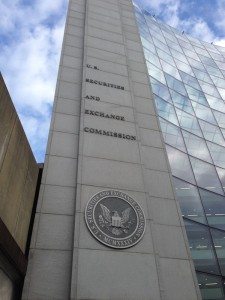This the second part, of a two part series, reviewing Bad Actors in private placements. The first article may be viewed here.
The Securities and Exchange Commission (SEC) issued new Rule 506(d) in 2013, a rule that bars felons and other specified “bad actors” from participating in private offerings of securities under Rule 506 of Regulation D under the Securities Act of 1933, which is the most powerful capital-raising tool available to private companies and private investment funds.
As we explained in Part I of this series, an issuer that embarks on a Rule 506 offering that has – even unknowingly – engaged a bad actor as an officer or director, has a bad actor directly or indirectly owning a large amount of shares or engages a bad actor to solicit investors, could embroil the company and otherwise blameless officers and directors in the criminal enterprise of an illegal securities offering. But if the issuer can show that it did not know of the disqualification and, in the exercise of reasonable care, could not have known that a disqualification existed, it can avoid liability for itself and its associates. As a result, Rule 506(d) effectively requires a company to exercise reasonable care to determine that none of its officers, directors, owners and other associates has committed a disqualifying bad act.
Part II of this series provides more detail on the persons who may be disqualified under the bad actor rule and the specific bad acts identified in the rule. It also outlines a phased approach to bad actor due diligence, intended to remain practical and efficient while satisfying the requirement for reasonable care.
In determining when an investigation goes beyond the reasonable, it is useful to keep in mind that neither Congress nor the SEC intended to regulate Rule 506 out of existence. To the contrary, the JOBS Act, new Rule 506(c) permitting general solicitations and positive statements of the SEC’s director and others about increasing use of Rule 506(c) all show intent to encourage the appropriate use of Rule 506. Therefore, reasonable Rule 506(d) due diligence should not add prohibitive costs to an offering unless the investigation uncovers wrongdoing or other problems that require broadened investigation and remediation beyond the investigation’s original purpose.
Covered Persons
Covered persons who are subject to disqualification or disclosure under 506(d) generally fall into four broad categories:
- The issuer itself
- Individuals who control the issuer
- Beneficial owners – individuals or companies that control 20% or more of the issuer’s voting securities
- Individuals and companies associated with the offering
The Bad Acts
The bad acts specified under Rule 506(b) generally fall into the following categories, which are described in terms of the sanctions imposed by courts or administrative agencies:
- Convictions for crimes – either felonies or misdemeanors – involving securities
Court orders or decrees that bar the covered person from specific activities involving securities - Orders of state and federal banking, insurance and commodities regulators
- SEC orders that prohibit a covered person from engaging in specified business activities or order a person to stop committing fraud or illegal offerings
- Expulsion from membership in a securities exchange or a national securities association for failing to follow just and equitable principles of trade
- Making or underwriting a registered offering that was stopped or suspended by the SEC or is currently the subject of investigations or proceedings for a stop order or suspension
- Orders of the U.S. Postal Service related to false representations (i.e., mail fraud).
The Rule has varying “look back” periods for the bad acts. Generally, a bad act disqualifies the covered person or must be disclosed (if the act falls within the grandfathering period) if it occurred within five years of the contemplated Rule 506 offering. However, criminal convictions for covered persons other than the issuer have a look-back period of ten years. Orders that bar the covered person from business activities or enjoin the covered person from committing wrongful acts will be disqualifying bad acts if the bar or injunction is effective at the time of the contemplated Rule 506 offering.
Phased Due Diligence Review
 Officers and advisors of a company contemplating a Rule 506 offering should begin the due diligence process early. If a company expects, even on the distant horizon, to conduct a Rule 506 offering in the future, bad actor due diligence should be an ongoing process, integrated into the general background checks performed when engaging officers, directors and contracting with advisors.
Officers and advisors of a company contemplating a Rule 506 offering should begin the due diligence process early. If a company expects, even on the distant horizon, to conduct a Rule 506 offering in the future, bad actor due diligence should be an ongoing process, integrated into the general background checks performed when engaging officers, directors and contracting with advisors.
This article lays out a phased approach to the Rule 506(d) process – it is just one manner by which bad actor checks might be accomplished. Rather than leaping to the minute criteria of the Rule, one could begin with broad categories of potential acts. While this approach will result in “false positives” – people who have committed misdeeds that don’t ultimately disqualify them – for the majority of companies it will rule out bad acts for the vast majority of covered persons, eliminating the need to investigate further. When a potential problem is found, the investigator can more closely examine the conduct and determine if it falls within the bad acts.
An officer of the issuer should be mindful of the general categories of covered persons and bad acts and rely on securities counsel and investigators for the final determination of who may be disqualified or require bad act disclosure.
 Identification of Covered Persons. The first step in any inquiry will be to identify the covered persons. Directors, executive officers, officers preparing offering materials or communicating with investors, financial advisors and brokers are all easily identified and classified as covered persons. The issuer should work with securities counsel to determine if covered persons exist in any of the rules more technically defined categories.
Identification of Covered Persons. The first step in any inquiry will be to identify the covered persons. Directors, executive officers, officers preparing offering materials or communicating with investors, financial advisors and brokers are all easily identified and classified as covered persons. The issuer should work with securities counsel to determine if covered persons exist in any of the rules more technically defined categories.
Phase One Review. A phase one review might include a questionnaire with checklist of bad acts and room for explanation. It is important to note that because it is not reasonable to assume that bad actors always tell the truth, questionnaires alone are not sufficient. However, they can flag problems for both the covered person and the issuer that warrant a deeper analysis. A brief questionnaire with a few broad questions, rather than simply cutting and pasting the entire text of Rule 506(d) and adding checkboxes, would be the goal during phase one. This may risk false positives, but simplifies the process for all concerned. For example, “Have you ever been the subject of an order issued by any state or federal agency?” will cover many of the Bad Act categories, and the vast majority of respondents will check “no.” For those who check yes, the issuer can inquire further whether the order came from a bank or securities regulator and about the content of the order.
 The next part of review will involve a search of public records. Most companies will engage an outside investigator for this purpose. Some of these searches should be tailored – for example a check for good standing with FINRA may be sufficient for a broker dealer. But in general the search should include:
The next part of review will involve a search of public records. Most companies will engage an outside investigator for this purpose. Some of these searches should be tailored – for example a check for good standing with FINRA may be sufficient for a broker dealer. But in general the search should include:
- Confirmation of identity and all names used the covered person
- Search engines (e.g. Google), social networking sites and news databases
- Federal criminal databases
- Disciplinary records of the SEC, CFTC, federal banking authorities and the U.S Postal Service
Criminal records and disciplinary records of securities, banking and insurance regulators in states where the covered person lived or worked during the past ten years
The searches should include not just the individual’s name, but the individual’s employers. The investigator should give careful thought as to what other names and aliases the covered person may have used to provide confidence that the searches conducted would have reasonably disclosed any of the bad acts in the U.S. and states where the individual reasonably may have lived.
Any positive findings should be discussed with securities counsel to determine if it is a bad act that disqualifies the covered person or requires disclosure.
Phase Two Review
 The issuer should initiate a Phase Two investigation into the specific details of any bad act detected during Phase One. In addition, further investigation if warranted if any other “red flags” appeared during Phase One. Red flags will vary by business or industry, and officers of the issuer should discuss with investigators specific issues to watch for. Some of the more common red flags would be:
The issuer should initiate a Phase Two investigation into the specific details of any bad act detected during Phase One. In addition, further investigation if warranted if any other “red flags” appeared during Phase One. Red flags will vary by business or industry, and officers of the issuer should discuss with investigators specific issues to watch for. Some of the more common red flags would be:
- A “near miss” – the investigation discovers that the covered person committed an act that would have been a bad act under Rule 506(d) if it had occurred more recently or in a different industry
- Unexplained loss or lapse of a professional license in the securities or financial industry
- Civil suits or criminal proceedings alleging fraud or deception in industries not involving finance or securities
- Serving as an officer, director or employee of an entity charged or sued for fraudulent acts, especially a pattern of such acts.
If Phase One identified any red flags and the failure to disclose the red flag on the questionnaire was a false response, the issuer should follow up with the individual to understand the reason for the omission, to make further inquiries and (apart from offering concerns) consider whether grounds exist to terminate the individual’s employment or engagement by the issuer.
 The issuer should also consider whether conducting more targeted searches in the area or industry of the red flag activity is warranted. It would also be advisable to broaden the search of state criminal records and regulatory agencies to include additional states where the covered person may have lived or worked as well as criminal records and disciplinary records of securities, banking and insurance regulators in states where the covered person lived or worked during the past ten years.
The issuer should also consider whether conducting more targeted searches in the area or industry of the red flag activity is warranted. It would also be advisable to broaden the search of state criminal records and regulatory agencies to include additional states where the covered person may have lived or worked as well as criminal records and disciplinary records of securities, banking and insurance regulators in states where the covered person lived or worked during the past ten years.
Conclusion
No investigation is perfect – even the most exhaustive investigation may fail to discover a covered person’s bad acts, even as it depletes the issuer’s resources. Fortunately, the due diligence defense under Rule 506(b) and the regulators enforcing it do not require perfection; rather a reasonable inquiry is all that is required. Advance planning and careful formulation of the investigation process can assure that reasonably detectible bad acts are, in fact, detected and that the proceeds of the offering benefit the issuer and not its investigators and lawyers.
 Jor Law is a co-founder of Homeier & Law, P.C., where he practices corporate and securities law, including helping companies take advantage of alternative forms of capital raising such as Regulation D, Rule 506(c) offerings and crowdfunding. He is also a co-founder of VerifyInvestor.com, the resource for accredited investor verifications trusted by broker-dealers, law firms, companies, and investors who insist on safety and reliability.
Jor Law is a co-founder of Homeier & Law, P.C., where he practices corporate and securities law, including helping companies take advantage of alternative forms of capital raising such as Regulation D, Rule 506(c) offerings and crowdfunding. He is also a co-founder of VerifyInvestor.com, the resource for accredited investor verifications trusted by broker-dealers, law firms, companies, and investors who insist on safety and reliability.
 Charles Kaufman, Counsel at Homeier & Law P.C., has been advising growing companies and their leaders for 20 years. In private law firms and as general counsel of a public company he has helped his clients to create, finance, govern, combine and exit their businesses, and to form strategic alliances, across a broad range of industries, including medical devices, healthcare, software, nanotechnology, film and music production, garment manufacturing, retailing, real estate investment and semiconductors. Charles advises early stage companies on obtaining both debt and equity capital from angel and venture capital investors, as well as expanded opportunities under Regulation 506(c) and the proposed crowdfunding rules of the JOBS Act. He has extensive experience advising public companies on securities regulation and compliance and advising both new and established companies in public and private securities offerings during a period of rapid change in the financial and regulatory landscape, from the still-emerging JOBS Act to Dodd-Frank and Sarbanes-Oxley. Charles earned both his J.D. and B.A. degrees at the University of California at Los Angeles. He is a member of the State Bar of California and serves on editorial board of its International Law Journal.
Charles Kaufman, Counsel at Homeier & Law P.C., has been advising growing companies and their leaders for 20 years. In private law firms and as general counsel of a public company he has helped his clients to create, finance, govern, combine and exit their businesses, and to form strategic alliances, across a broad range of industries, including medical devices, healthcare, software, nanotechnology, film and music production, garment manufacturing, retailing, real estate investment and semiconductors. Charles advises early stage companies on obtaining both debt and equity capital from angel and venture capital investors, as well as expanded opportunities under Regulation 506(c) and the proposed crowdfunding rules of the JOBS Act. He has extensive experience advising public companies on securities regulation and compliance and advising both new and established companies in public and private securities offerings during a period of rapid change in the financial and regulatory landscape, from the still-emerging JOBS Act to Dodd-Frank and Sarbanes-Oxley. Charles earned both his J.D. and B.A. degrees at the University of California at Los Angeles. He is a member of the State Bar of California and serves on editorial board of its International Law Journal.


